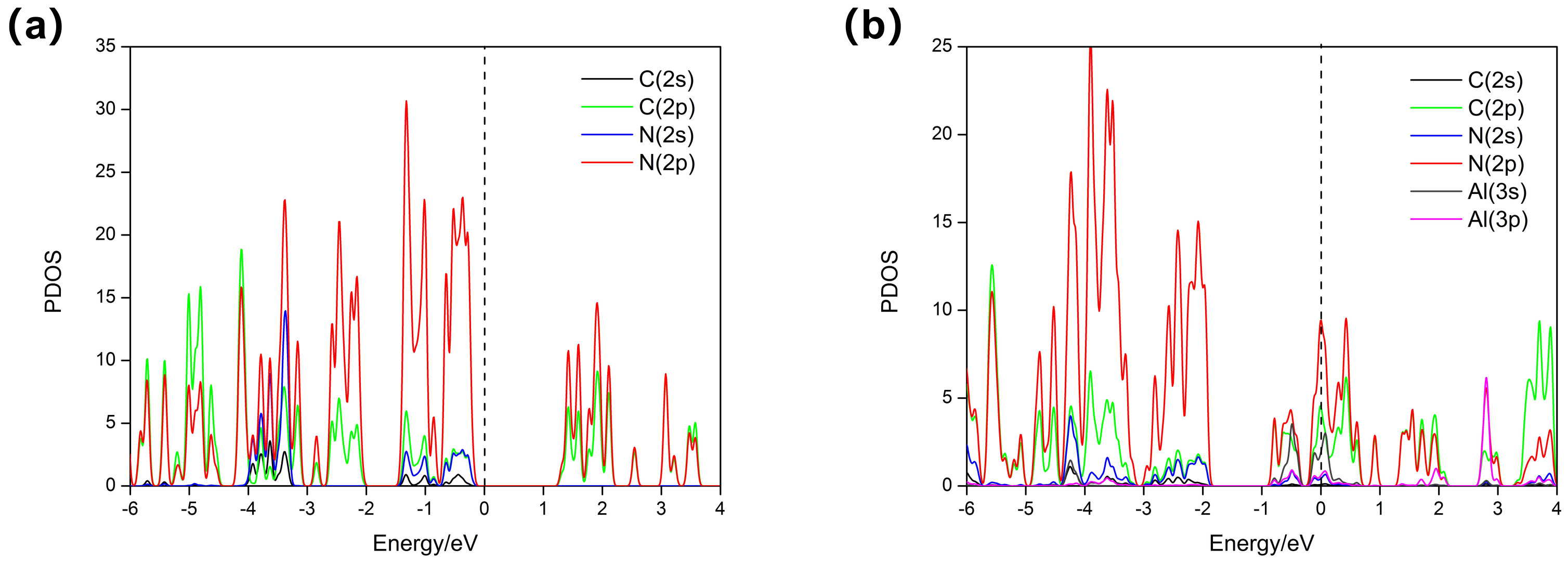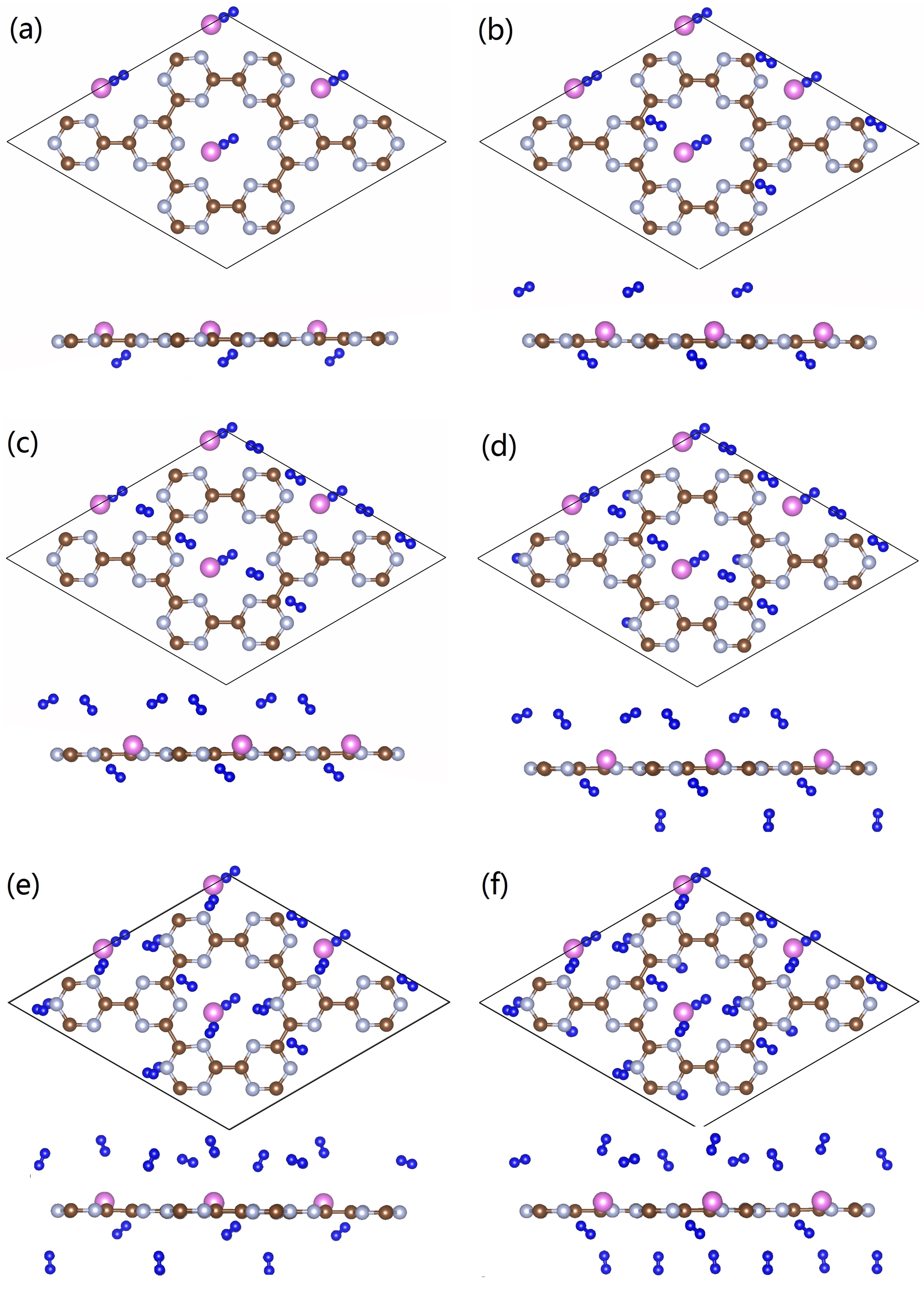Computational Evaluation of Al-Decorated g-CN Nanostructures as High-Performance Hydrogen-Storage Media
Abstract
1. Introduction
2. Materials and Methods
3. Results and Discussion
3.1. Structural Features of Al-Doped g-CN
3.2. Hydrogen-Storage Performance Using Al-Doped g-CN
4. Conclusions
Author Contributions
Funding
Data Availability Statement
Acknowledgments
Conflicts of Interest
References
- Züttel, A. Hydrogen storage methods. Naturwissenschaften 2004, 91, 157–172. [Google Scholar] [CrossRef]
- Allendorf, M.D.; Hulvey, Z.; Gennett, T.; Ahmed, A.; Autrey, T.; Camp, J.; Seon Cho, E.; Furukawa, H.; Haranczyk, M.; Head-Gordon, M.; et al. An assessment of strategies for the development of solid-state adsorbents for vehicular hydrogen storage. Energy Environ. Sci. 2018, 11, 2784–2812. [Google Scholar] [CrossRef]
- U.S. Department of Energy. Hydrogen and Fuel Cell Technologies Office Multi-Year Research, Development and Demonstration Plan; U.S. Department of Energy: Washington, DC, USA, 2014.
- Züttel, A. Materials for hydrogen storage. Mater. Today 2003, 6, 24–33. [Google Scholar] [CrossRef]
- Huang, Z.; Autrey, T. Boron–nitrogen–hydrogen (BNH) compounds: Recent developments in hydrogen storage, applications in hydrogenation and catalysis, and new syntheses. Energy Environ. Sci. 2012, 5, 9257–9268. [Google Scholar] [CrossRef]
- Teichmann, D.; Stark, K.; Müller, K.; Zöttl, G.; Wasserscheid, P.; Arlt, W. Energy storage in residential and commercial buildings via Liquid Organic Hydrogen Carriers (LOHC). Energy Environ. Sci. 2012, 5, 9044–9054. [Google Scholar] [CrossRef]
- Graetz, J. New approaches to hydrogen storage. Chem. Soc. Rev. 2009, 38, 73–82. [Google Scholar] [CrossRef] [PubMed]
- Bogdanović, B.; Schwickardi, M. Ti-doped alkali metal aluminium hydrides as potential novel reversible hydrogen storage materials1: Invited paper presented at the International Symposium on Metal-Hydrogen Systems. J. Alloys Compd. 1997, 253–254, 1–9. [Google Scholar]
- Sakintuna, B.; Lamari-Darkrim, F.; Hirscher, M. Metal hydride materials for solid hydrogen storage: A review. Int. J. Hydrog. Energy 2007, 32, 1121–1140. [Google Scholar] [CrossRef]
- Züttel, A.; Wenger, P.; Rentsch, S.; Sudan, P.; Mauron, P.; Emmenegger, C. LiBH4 a new hydrogen storage material. J. Power Sources 2003, 118, 1–7. [Google Scholar] [CrossRef]
- Gao, P.; Huang, Z.; Yu, H. Exploration of the Dehydrogenation Pathways of Ammonia Diborane and Diammoniate of Diborane by Molecular Dynamics Simulations Using Reactive Force Fields. J. Phys. Chem. A 2020, 124, 1698–1704. [Google Scholar] [CrossRef] [PubMed]
- Luo, W.; Zakharov, L.N.; Liu, S.Y. 1,2-BN Cyclohexane: Synthesis, Structure, Dynamics, and Reactivity. J. Am. Chem. Soc. 2011, 133, 13006–13009. [Google Scholar] [CrossRef] [PubMed]
- Luo, W.; Campbell, P.G.; Zakharov, L.N.; Liu, S.Y. A Single-Component Liquid-Phase Hydrogen Storage Material. J. Am. Chem. Soc. 2011, 133, 19326–19329. [Google Scholar] [CrossRef] [PubMed]
- Campbell, P.G.; Zakharov, L.N.; Grant, D.J.; Dixon, D.A.; Liu, S.Y. Hydrogen Storage by Boron-Nitrogen Heterocycles: A Simple Route for Spent Fuel Regeneration. J. Am. Chem. Soc. 2010, 132, 3289–3291. [Google Scholar] [CrossRef] [PubMed]
- Gao, P.; Zhang, J. Understanding the Dehydrogenation Pathways of Ammonium Octahydrotriborate (NH4B3H8) by Molecular Dynamics Simulations with the Reactive Force Field (ReaxFF). Adv. Theory Simul. 2020, 3, 2000139. [Google Scholar] [CrossRef]
- Gao, P.; Zhang, J. Understanding the Intra-Molecular Proton Transfer of Octahydrotriborate and Exploring the Dehydrogenation Pathways of NH4B3H8 by DFT Calculations. Adv. Theory Simul. 2021, 4, 2000287. [Google Scholar] [CrossRef]
- Holst, J.R.; Gillan, E.G. From Triazines to Heptazines: Deciphering the Local Structure of Amorphous Nitrogen-Rich Carbon Nitride Materials. J. Am. Chem. Soc. 2008, 130, 7373–7379. [Google Scholar] [CrossRef]
- Thomas, A.; Fischer, A.; Goettmann, F.; Antonietti, M.; Müller, J.O.; Schlögl, R.; Carlsson, J.M. Graphitic carbon nitride materials: Variation of structure and morphology and their use as metal-free catalysts. J. Mater. Chem. 2008, 18, 4893–4908. [Google Scholar] [CrossRef]
- Dong, G.; Zhang, Y.; Pan, Q.; Qiu, J. A fantastic graphitic carbon nitride (g-C3N4) material: Electronic structure, photocatalytic and photoelectronic properties. J. Photochem. Photobiol. C Photochem. Rev. 2014, 20, 33–50. [Google Scholar] [CrossRef]
- Wei, W.; Jacob, T. Strong excitonic effects in the optical properties of graphitic carbon nitride g-C3N4 from first principles. Phys. Rev. B 2013, 87, 085202. [Google Scholar] [CrossRef]
- Liu, G.; Xue, M.; Liu, Q.; Yang, H.; Zhou, Y. Facile synthesis of C-doped hollow spherical g-C3N4 from supramolecular self-assembly for enhanced photoredox water splitting. Int. J. Hydrog. Energy 2019, 44, 25671–25679. [Google Scholar] [CrossRef]
- Algara-Siller, G.; Severin, N.; Chong, S.Y.; Björkman, T.; Palgrave, R.G.; Laybourn, A.; Antonietti, M.; Khimyak, Y.Z.; Krasheninnikov, A.V.; Rabe, J.P.; et al. Triazine-Based Graphitic Carbon Nitride: A Two-Dimensional Semiconductor. Angew. Chem. Int. Ed. Engl. 2014, 53, 7450–7455. [Google Scholar] [CrossRef]
- Jürgens, B.; Irran, E.; Senker, J.; Kroll, P.; Müller, H.; Schnick, W. Melem (2,5,8-Triamino-tri-s-triazine), an Important Intermediate during Condensation of Melamine Rings to Graphitic Carbon Nitride: Synthesis, Structure Determination by X-ray Powder Diffractometry, Solid-State NMR, and Theoretical Studies. J. Am. Chem. Soc. 2003, 125, 10288–10300. [Google Scholar] [CrossRef]
- Wang, G.; Zhou, F.; Yuan, B.; Xiao, S.; Kuang, A.; Zhong, M.; Dang, S.; Long, X.; Zhang, W. Strain-Tunable Visible-Light-Responsive Photocatalytic Properties of Two-Dimensional CdS/g-C3N4: A Hybrid Density Functional Study. Nanomaterials 2019, 9, 244. [Google Scholar] [CrossRef]
- Fina, F.; Callear, S.K.; Carins, G.M.; Irvine, J.T.S. Structural Investigation of Graphitic Carbon Nitride via XRD and Neutron Diffraction. Chem. Mater. 2015, 27, 2612–2618. [Google Scholar] [CrossRef]
- Hussain, T.; Hankel, M.; Searles, D.J. Computational Evaluation of Lithium-Functionalized Carbon Nitride (g-C6N8) Monolayer as an Efficient Hydrogen Storage Material. J. Phys. Chem. C 2016, 120, 25180–25188. [Google Scholar] [CrossRef]
- Gao, P.; Li, J.; Wang, G. Computational evaluation of superalkali-decorated graphene nanoribbon as advanced hydrogen storage materials. Int. J. Hydrog. Energy 2021, 46, 24510–24516. [Google Scholar] [CrossRef]
- Liu, A.Y.; Cohen, M.L. Prediction of New Low Compressibility Solids. Science 1989, 245, 841–842. [Google Scholar] [CrossRef]
- Gao, P.; Li, J.; Zhang, J.; Wang, G. Computational exploration of magnesium-decorated carbon nitride (g-C3N4) monolayer as advanced energy storage materials. Int. J. Hydrog. Energy 2021, 46, 21739–21747. [Google Scholar] [CrossRef]
- Chen, X.; Li, J.W.; Dou, X.; Gao, P. Computational evaluation of Mg-decorated g-CN as clean energy gas storage media. Int. J. Hydrog. Energy 2021, 46, 35130–35136. [Google Scholar] [CrossRef]
- Nair, A.A.; Sundara, R.; Anitha, N. Hydrogen storage performance of palladium nanoparticles decorated graphitic carbon nitride. Int. J. Hydrog. Energy 2015, 40, 3259–3267. [Google Scholar] [CrossRef]
- Ruan, L.; Xu, G.; Gu, L.; Li, C.; Zhu, Y.; Lu, Y. The physical properties of Li-doped g-C3N4 monolayer sheet investigated by the first-principles. Mater. Res. Bull. 2015, 66, 156–162. [Google Scholar] [CrossRef]
- Zhu, G.; Lü, K.; Sun, Q.; Kawazoe, Y.; Jena, P. Lithium-doped triazine-based graphitic C3N4 sheet for hydrogen storage at ambient temperature. Comput. Mater. Sci. 2014, 81, 275–279. [Google Scholar] [CrossRef][Green Version]
- Zhang, Y.; Sun, H.; Chen, C. New template for metal decoration and hydrogen adsorption on graphene-like C3N4. Phys. Lett. A 2009, 373, 2778–2781. [Google Scholar] [CrossRef]
- Wu, M.; Wang, Q.; Sun, Q.; Jena, P. Functionalized Graphitic Carbon Nitride for Efficient Energy Storage. J. Phys. Chem. C 2013, 117, 6055–6059. [Google Scholar] [CrossRef]
- Gao, Z.; Wang, L.; Wang, L.; Huang, J.; She, H.; Wang, Q. Construction of heterostructured g-C3N4@TiATA/Pt composites for efficacious photocatalytic hydrogen evolution. Int. J. Hydrog. Energy 2019, 44, 24407–24417. [Google Scholar] [CrossRef]
- Panigrahi, P.; Kumar, A.; Karton, A.; Ahuja, R.; Hussain, T. Remarkable improvement in hydrogen storage capacities of two-dimensional carbon nitride (g-C3N4) nanosheets under selected transition metal doping. Int. J. Hydrog. Energy 2020, 45, 3035–3045. [Google Scholar] [CrossRef]
- Wei, J.; Huang, C.; Wu, H.; Kan, E. High-capacity hydrogen storage in Li-adsorbed g-C3N4. Mater. Chem. Phys. 2016, 180, 440–444. [Google Scholar] [CrossRef]
- Tranca, D.C.; Seifert, G. A First-Principles Study of Metal-Decorated Graphene Nanoribbons for Hydrogen Storage. Z. Phys. Chem. 2016, 230, 791–808. [Google Scholar] [CrossRef]
- Ngqalakwezi, A.; Nkazi, D.; Seifert, G.; Ntho, T. Effects of reduction of graphene oxide on the hydrogen storage capacities of metal graphene nanocomposite. Catalysis Today 2020, 358, 338–344. [Google Scholar] [CrossRef]
- Li, J.; Cao, C.; Hao, J.; Qiu, H.; Xu, Y.; Zhu, H. Self-assembled one-dimensional carbon nitride architectures. Diam. Relat. Mater. 2006, 15, 1593–1600. [Google Scholar] [CrossRef]
- Chen, Y.D.; Yu, S.; Zhao, W.H.; Li, S.F.; Duan, X.M. A potential material for hydrogen storage: A Li decorated graphitic-CN monolayer. Phys. Chem. Chem. Phys. 2018, 20, 13473–13477. [Google Scholar] [CrossRef]
- Kresse, G.; Furthmüller, J. Efficient iterative schemes for ab initio total-energy calculations using a plane-wave basis set. Phys. Rev. B 1996, 54, 11169–11186. [Google Scholar] [CrossRef]
- Grimme, S. Semiempirical GGA-type density functional constructed with a long-range dispersion correction. J. Comput. Chem. 2006, 27, 1787–1799. [Google Scholar] [CrossRef]
- Perdew, J.P.; Wang, Y. Pair-distribution function and its coupling-constant average for the spin-polarized electron gas. Phys. Rev. B 1992, 46, 12947–12954. [Google Scholar] [CrossRef]
- Perdew, J.P.; Burke, K.; Ernzerhof, M. Generalized Gradient Approximation Made Simple. Phys. Rev. Lett. 1996, 77, 3865–3868. [Google Scholar] [CrossRef]
- Blöchl, P.E. Projector augmented-wave method. Phys. Rev. B 1994, 50, 17953–17979. [Google Scholar] [CrossRef]
- Monkhorst, H.J.; Pack, J.D. Special points for Brillouin-zone integrations. Phys. Rev. B 1976, 13, 5188–5192. [Google Scholar] [CrossRef]
- Chadi, D.J. Special points for Brillouin-zone integrations. Phys. Rev. B 1977, 16, 1746–1747. [Google Scholar] [CrossRef]
- Bader, R. Atoms in Molecules—A Quantum Theory; Oxford University Press: Oxford, UK, 1990. [Google Scholar]








| System | Adsorption E | H−H Bond | Capacity |
|---|---|---|---|
| Al4C24N24 + 4H2 | −0.31 | 0.787 | 1.10 |
| Al4C24N24 + 8H2 | −0.19 | 0.770 | 2.14 |
| Al4C24N24 + 12H2 | −0.15 | 0.765 | 3.17 |
| Al4C24N24 + 16H2 | −0.13 | 0.762 | 4.12 |
| Al4C24N24 + 20H2 | −0.13 | 0.762 | 5.18 |
| Al4C24N24 + 24H2 | −0.11 | 0.759 | 6.15 |
Publisher’s Note: MDPI stays neutral with regard to jurisdictional claims in published maps and institutional affiliations. |
© 2022 by the authors. Licensee MDPI, Basel, Switzerland. This article is an open access article distributed under the terms and conditions of the Creative Commons Attribution (CC BY) license (https://creativecommons.org/licenses/by/4.0/).
Share and Cite
Gao, P.; Chen, X.; Li, J.; Wang, Y.; Liao, Y.; Liao, S.; Zhu, G.; Tan, Y.; Zhai, F. Computational Evaluation of Al-Decorated g-CN Nanostructures as High-Performance Hydrogen-Storage Media. Nanomaterials 2022, 12, 2580. https://doi.org/10.3390/nano12152580
Gao P, Chen X, Li J, Wang Y, Liao Y, Liao S, Zhu G, Tan Y, Zhai F. Computational Evaluation of Al-Decorated g-CN Nanostructures as High-Performance Hydrogen-Storage Media. Nanomaterials. 2022; 12(15):2580. https://doi.org/10.3390/nano12152580
Chicago/Turabian StyleGao, Peng, Xihao Chen, Jiwen Li, Yue Wang, Ya Liao, Shichang Liao, Guangyu Zhu, Yuebin Tan, and Fuqiang Zhai. 2022. "Computational Evaluation of Al-Decorated g-CN Nanostructures as High-Performance Hydrogen-Storage Media" Nanomaterials 12, no. 15: 2580. https://doi.org/10.3390/nano12152580
APA StyleGao, P., Chen, X., Li, J., Wang, Y., Liao, Y., Liao, S., Zhu, G., Tan, Y., & Zhai, F. (2022). Computational Evaluation of Al-Decorated g-CN Nanostructures as High-Performance Hydrogen-Storage Media. Nanomaterials, 12(15), 2580. https://doi.org/10.3390/nano12152580






